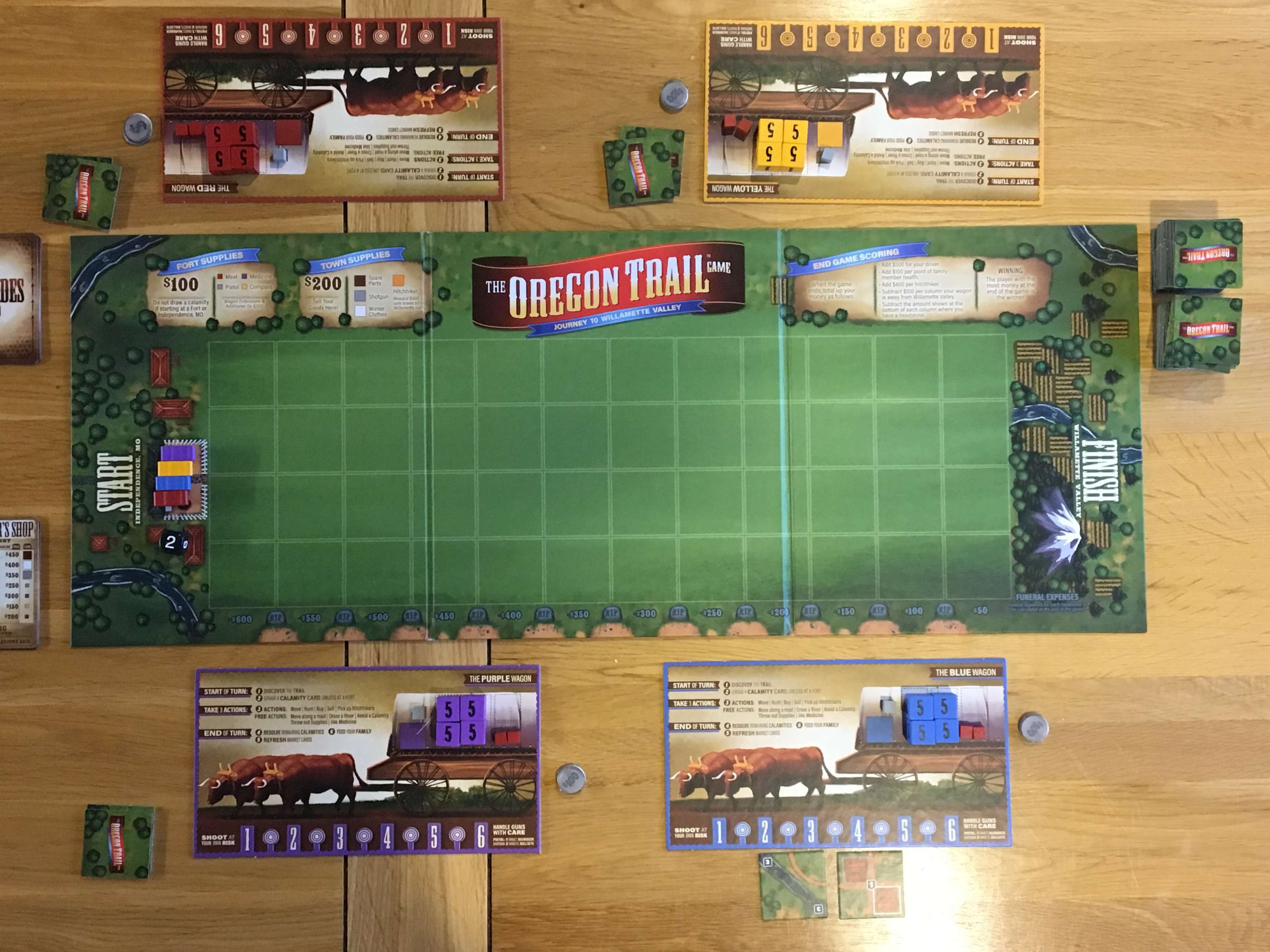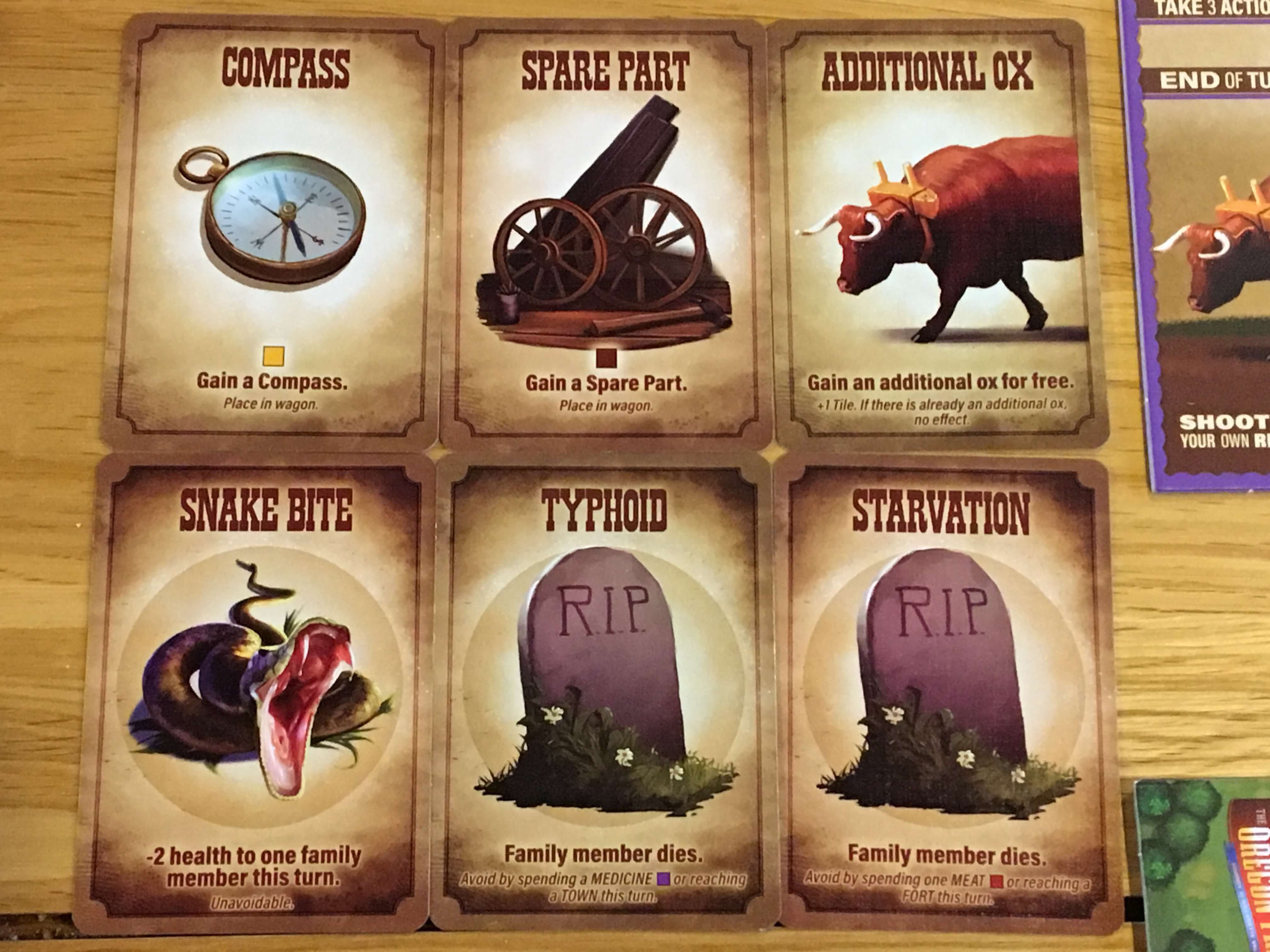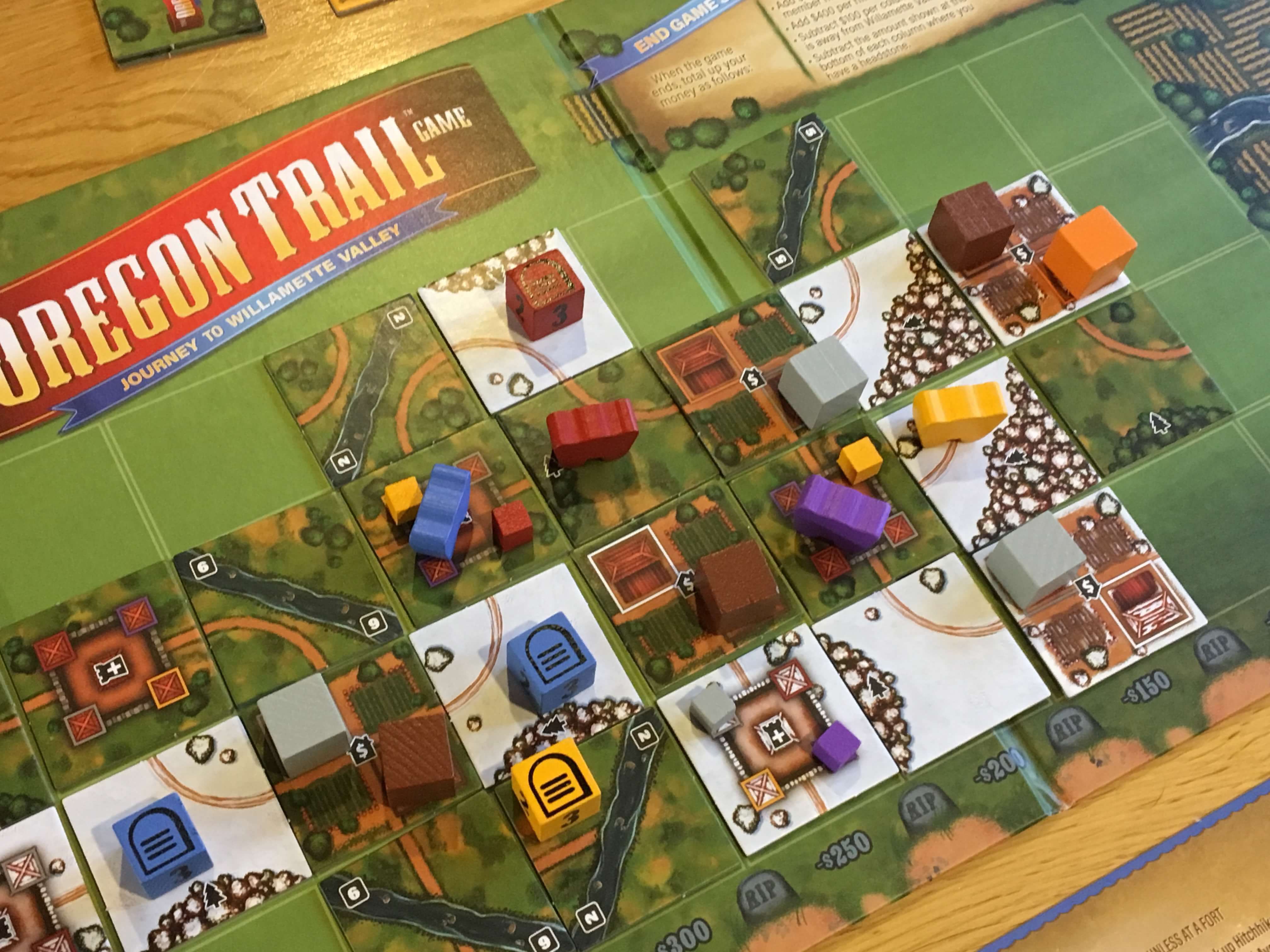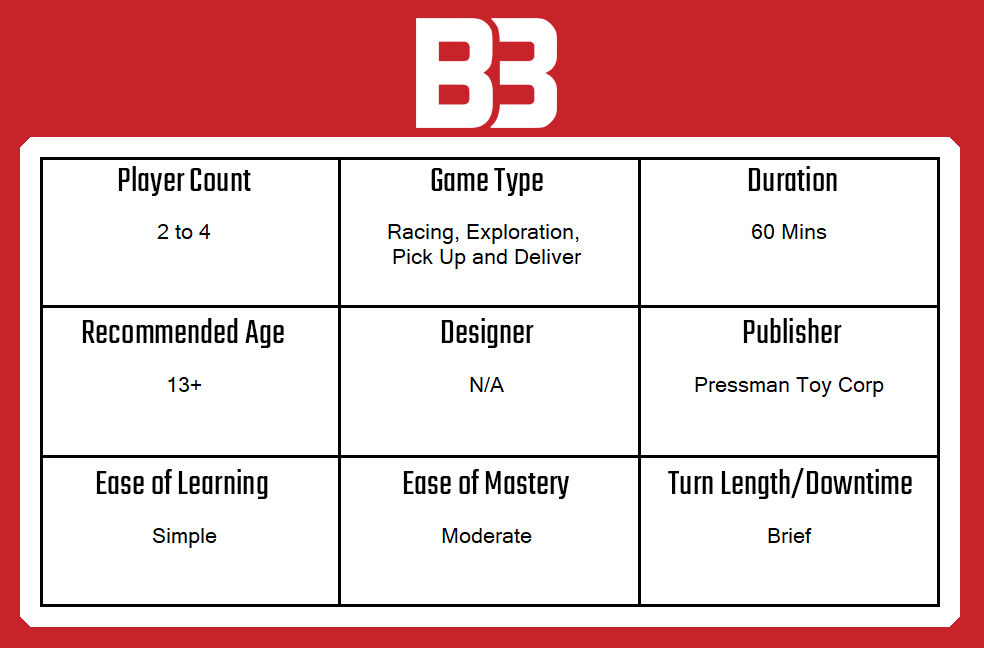A board game attempt at a classic video game, The Oregon Trail Game: Journey to Willamette Valley is an adaption of a giant, but how well does it all come together?
- For the hundreds, nay, thousands of people who travelled The Oregon Trail, thoughts of what was or wasn’t fair will rarely have come into it. They simply lived or died — the majority of people who fell into the latter category most frequently succumbing to cholera, scurvy or similar diseases of the era. Modern gamers have it easy by comparison, so we have all the time in the world to moan about what’s fair, which is something that the various creators of Oregon-Trail-themed games know only too well. Enter, then, Journey to Willamette Valley.
- Today’s review focuses on the 2018 game from Pressman Toys, which (to refer to its full title) is known as The Oregon Trail: Journey to Willamette Valley. Will this Target-store exclusive fair any better than its predecessors in winning fans? Let’s find out.
Overview
Although I haven’t played every video and tabletop game interpretation of The Oregon Trail there has been, I have played the most famous of them. One of those, as most people will remember, is the ridiculously unfair, hugely random and thoroughly frustrating Commodore 64 game that ultimately spawned an equally annoying card game. It was also followed by at least a couple of other video games, one of which was basically a full-motion, point-and-click adventure that was more boring than anything else.
Few of these games, in my opinion, really captured the sense of being on a journey, but Pressman Toy’s Journey to Willamette Valley most certainly does. Two to four players each begin with a player board that represents their wagon. On it, they’ll find four family members that are represented by large cubes, as well as a number of spaces for smaller cubes, which can hold pistols, food, medicine and similar. It won’t take the players long to work out that four of the smaller cubes fit inside one of the larger ones, which sort of means that family members might feel a bit like they are getting in the way at some point.
Luckily, much like the previous games to bear the moniker of The Oregon Trail, death comes quickly enough. Aside from the player boards, the central playing area is represented by a long and thin board, empty to begin with. As players progress from one side to the other, they place new tiles onto the board, building out the trail and adding hazards like rivers, as well as occasionally helpful areas such as forts or stores. Event cards dish out new challenges like broken wheels, diseases, snake bites and other calamities. With all that said, whilst you might welcome a bit more room in the wagon, dead family members get placed where they fall, each of them costing the player in points (that represent funeral expenses) come the end of the game.

Components
The component quality in Journey to Willamette Valley is fairly high in my opinion, with every cardboard piece cut thick, with clear, quality printing on them. The player boards clearly depict the space on a wagon in a way I found very intuitive, whilst the cubes that make up the cargo are also very fitting. In particular, I love the family member cubes, each of which has a countdown from ‘5’ to ‘RIP’ on it, depicting the toll that famine, wounds and other afflictions take on the family.
When someone does die, their die, with the RIP tombstone facing up, is placed onto that space on the board, which is in itself cut from thick card. Each of the tiles that sit on it is bright and clear, with roads, rivers, forts and other features clearly on display, offering no ambiguity as to how you can achieve a legal placement. Even though the board begins with very little on it, it soon fills out and actually looks fairly interesting by the end. There are a lot of tiles to work through and you’ll never see the same layout twice, which is definitely a bonus in my opinion.
The cards and other components in Journey to Willamette Valley are also of a very high standard throughout, although I guess the closer you look, some cracks do appear. The cards, for example, are very well made and feature clear, concise information, but much of the artwork is reused across several cards and at its best, it’s functional. Tombstones (indicating death) are commonly used, for example, rather than the cause of death itself — be it disease, an accident or something else like a snakebite. The instruction manual is clear enough and I learned the game from it alone, with no tutorial or playthrough videos available at the time.

Turn Structure
Journey to the Willamette Valley is simple enough to play and will typically only last for about an hour or so, although it can be a lot less than that with fewer players and if the run of luck for one or both players goes badly in their favour. Each turn, players simply take three actions from a range that includes moving, hunting, buying or selling and similar. A few actions can be affected by other factors, such as when crossing rivers: players may either play it safe (for all their movement allowance) or attempt to cross quickly, which introduces an element of risk via dice rolling.
Moving, for the most part, is as simple as it sounds — except for when rivers are concerned. Hunting, however, introduces a sort of minigame in is own right, wherein players must guess at the number on a card that is then drawn — if they get it right, they win and get some meat. Taking a shotgun instead of a pistol lets them narrow the odds somewhat, but a shotgun is an expensive upgrade that takes up space, so as always, there’s a decision to make there. Buying and selling is fairly obvious, except that the price of goods is set by a market card that is constantly refreshed, meaning that players will need to make the most of opportunities to buy low and sell high, since there will rarely be a second chance.
Turns in Journey to the Willamette Valley are rarely a concern in terms of how you do what you need to do, but more a case of understanding what must be done. This is because on most turns, there’ll be some urgent need to address such as obtaining food, buying winter clothes, getting medicine or similar. Because this is a racing game about getting to the end of the trail, you’ll need to make sure that each turn both moves you forward and (to the best of your ability) keeps your family alive and capable of making money when it reaches the destination.

Game Experience
Whilst many aspects in Journey to Willamette Valley are affected by luck, there’s much less of it here than there has been in previous games based on The Oregon Trail and the luck there is, dare I say it, feels a bit less unfair. Sure, you will occasionally draw a card that states RIP and indicates that someone will die if you don’t do something — but you usually have a full set of turns to do whatever that something is. This can (and will) result in deaths from time to time, but on other occasions it results in plotting a marvellous route through the mountainous terrain that leads back to a fort where medicine is for sale.
Luck aside, I just like how Journey to Willamette Valley plays. The board builds out rapidly and it sparks real curiosity among those playing — what will the next tile reveal? Where will it go? Who will it help? The event cards I mentioned earlier promote real excitement on occasion, but based on the majority of my plays, I rarely found them unfair. At worst, the bad beats in Journey to Willamette Valley are even-handed in their propensity to hand out random death and destruction. On the other hand, the event deck is just as likely to dish out beneficial cards like spare parts or compasses as it is a deadly malady.
With a spirit of adventure that far outstrips most other, similar games, as well as a set of components that I think perfectly fit the brief, Journey to Willamette Valley is much more fun than I was expecting it to be. It’s a game that is capable of creating the feeling of a sense of achievement when you win, or simply because you also made it to the end — whatever state your family might be in.

Conclusion
I don’t want to repeat the old cliche, but Journey to Willamette Valley is a game that can tell stories, which is something I applaud in all forms. It is by no means a perfect game thanks to a high amount of luck and limited ability for players to influence the outcome. Despite those things, it’s always fun to have to handle the challenges that the game poses from one turn to the next. Arguably this is the only really puzzling element to the gameplay in Journey to Willamette Valley, but veteran players will enjoy rising to the challenge all the same.
Journey to Willamette Valley is a fairly unique racing game that has a lot of theme running throughout both its gameplay mechanics and its components. The family cubes, for example, and the space for cargo, makes for a wonderful interplay between attempting to run fast and loose all the way versus working your way slowly through the terrain, sticking close to forts and crossing rivers carefully. These small decisions can lead to spiralling consequences, which I think captures the spirit of the classic ‘Turn West: you are dead’ style of gameplay, but with much less frustration and usually, an opportunity to correct the course. Overall, Journey to Willamette Valley is a decent addition to any collection, especially if you’re a fan of the concept, or the idea, of journeying in The Old West.
A copy of The Oregon Train: Journey to Willamette Valley was provided for review purposes. You can find out more about it on the website of publisher Pressman Toys.
Love board games? Check out our list of the top board games we’ve reviewed.

Why is the board backwards? Did the geniuses that designed it forget that travel was from east to west? Basic geography must be tough for people